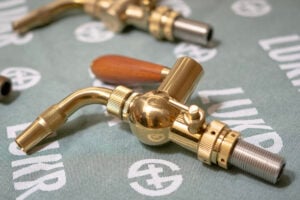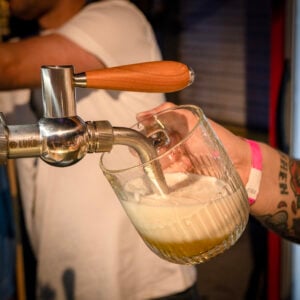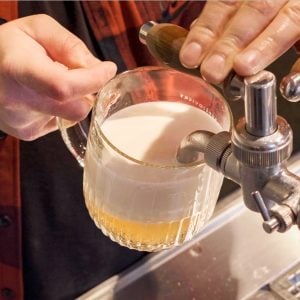A Journey Into Czech Lager with Budvar pt3
Last time we uncovered the secrets of Budvar’s special recipe. But it’s not just how it’s brewed – the way their beer is served makes a huge difference too.
A great finish
The Czechs like to say that the brewmaster only brews the beer: the tapster “makes” it. That’s not too bizarre a notion when you think about it. Imagine Guinness poured from a plastic keg, or Stella Artois through a handpull! They’d be completely different drinking experiences, and they would fundamentally alter the way you perceived the flavour.
The classic pour for a Czech pilsner has a pillow of dense, sweet, wet foam above a golden body of beer. The thick foam protects the beer below from the air, keeping the flavour fresh to the last sip, while the wide tankard promotes malty aromas.

You’ll notice if you drink an authentically served Czech lager that the foam is finer and denser than most lagers served in British pubs. This is down to the side pour taps traditionally used. Side pour taps are simple in concept, but finely engineered for the best result – a bit like pilsner itself. The key differences are a horizontally mounted ball valve – as opposed to a standard vertical plunger valve – and a longer faucet designed to be plunged into the beer as it pours, instead of dispensing from above the beer line.

Lukr produce some of the best side pour taps available, refining their products for over 100 years. At the heart of their taps is a specially designed ball valve, allowing the serve to be precisely controlled. Add to that integrated flow control and a microscreen to condition the foam, and you have the vital features you need for the perfect pour.
A Lukr tap is more expensive than regular beer taps, but with good maintenance of seals and gaskets, they can last you a lifetime. If you’re serious about authentic pilsner, they’re a great investment. When you take a lot of time brewing a great beer, it makes sense to take equal care serving it well!
Secrets of serving
Budvar train bar staff and tapsters from across the Czech Republic at their training centre. When we visited, they were kind enough to share their processes with us – and so we’re sharing them with you.
The first step is scrupulously clean glassware. In particular, grease is the enemy, as this will kill head retention, and it’s important that the head remains intact to the last sip.
While most busy pubs use dishwashers, Budvar prefer their glasses to be cleaned by hand. They recommend using a separate sponge that is only ever used to clean beer glasses – never other dishes in your kitchen – and plain, unscented dish soap. You don’t want your pilsner tasting of artificial lemons…

Next, they make sure their glassware is at the same temperature as the beer. This helps again with head retention, as differences in temperature have a big effect on how foamy your pour is, but it also means that the glass is neither warming nor cooling the beer in the keg. It’s like warming your plates – no-one wants a perfectly seared steak dumped on a freezing cold plate.
Budvar store freshly washed glasses in a chilled water bath to get it to the right temperature. At home, you could fill your clean glass with plain water and put it in the fridge ahead of serving. You could also fill the glass with iced water. Don’t be tempted to freeze your glassware – the frosting looks cool, but it’s too cold for authentic pilsner and you’ll lose delicate hop and malt flavours.
After a final rinse – you might use a turbo washer for a taproom experience – the pour can begin!
A Lukr tap works very simply. The tap can be opened up to 90°: 0° is closed, 1-20° delivers foam, and 20-90° is beer. This means you can really dial in the exact amount of foam you want.

For a simple one-step pour, start with your clean, chilled, and rinsed glass. Put the faucet all the way to the bottom of the glass and open the tap to foam. Once the faucet is submerged by foam, open the tap fully (to get beer) and fill to the top. Make sure you keep the faucet at the bottom of the glass the whole time – the head keeps the beer underneath away from the air.

You can also do a two-step pour. Begin as above with a protective layer of foam, then fill with beer but stop at the 2/3 level. Let the glass sit for thirty seconds, then put the glass back to the tap, submerge the faucet beneath the beer to the bottom, then open the tap fully and fill to the top.
This two step pour reduces the overall carbonation of the beer as some of the carbon dioxide escapes in the gap between the two steps. You also get better head retention because the head from the first pour stabilises and thickens up, with the second step filling from underneath this more stable head. This is the same idea behind the famous Guinness two-step pour.
Budvar use the one-step method for their more bitter beers, such as Budvar 33. For their classic pilsner, they recommend the two-step pour.
Other pours
As well as the standard one- and two-step pours, there are some other traditional servings for Czech lager.
A taster pour (also called a šnyt) is traditionally given to brewery representatives checking the quality of beer in Czech pubs. This is a one-step pour with a little more foam than normal. Begin with a normal one-step but with some extra foam. Then continue as normal, but stop one finger’s width from the top of the glass. The perfect proportion is two fingers of beer, topped with three fingers of foam, and one finger of headspace.
The foam on this pour seems “wetter” and alters the overall perception of the beer. It’s a refreshing drink that goes well with food.
There’s also the famous mlíko – or “milk” – pour, which is almost entirely foam. To make this, barely open the tap, add foam slowly, and keep pouring foam to the top of the glass. Foam is caused when carbon dioxide dissolved in the beer is released, so a fully foamed pint is actually less gassy than a regular pour – making this a super smooth and refreshing drink. The traditional way to sup a mlíko is to drink it in one go – down the hatch!

Join us in the final part of this blog series where we cover how to make your best Pilsner at home – including how to adapt Budvar’s methods at homebrew scale.
Plus you can check out our four part video series with Budvar as we dig deep into the secrets of Czech lager! And remember to subscribe to our YouTube channel for all the latest brews and reviews from The Malt Miller.

